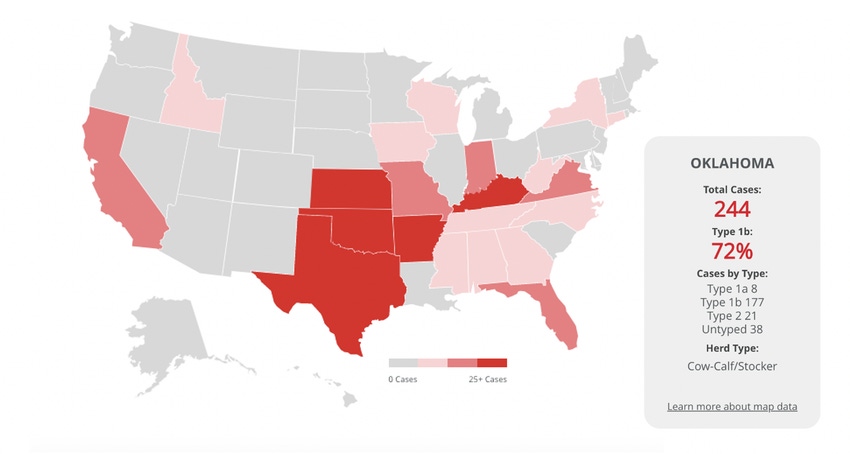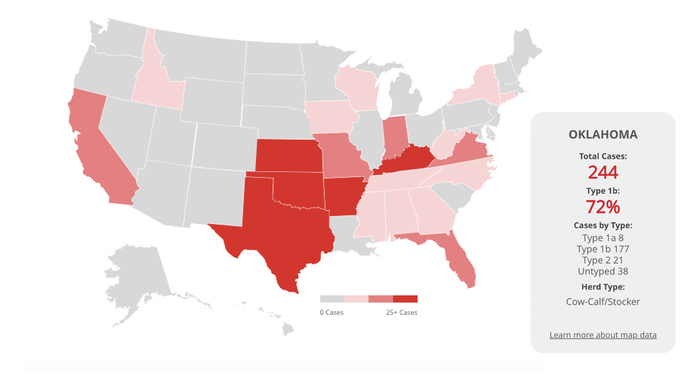BVDV Type 1b prevalence continues to rise in cattle herds across the country.
September 3, 2020

Bovine viral diarrhea virus (BVDV) spreads easily through livestock environments, including feed and water. It invades the animal’s respiratory and reproductive systems, moving between heifers, cows, calves, steers and bulls. Not only does it spread easily and often shows very few clinical signs, this complex virus continues to present new strains with shifting viral subtypes.
Thirty years ago, the majority of BVDV cases were caused by Type 1a. In recent decades, Type 1b has emerged as the most prevalent subspecies of BVDV in the United States, and unfortunately, continues to present a significant challenge to cattle herd performance and profitability.
One reason for the shift is that viruses can mutate to escape detection by the animal’s immune system. But some experts theorize that Type 1b may have gained dominance by taking advantage of gaps in protection left by vaccines that haven’t adequately stimulated immunity against this disease threat.

Successful BVDV prevention strategies focus on Type 1b
Whether yours is a cow-calf, stocker or feedlot operation, when your cattle are exposed to BVDV it’s very likely that you’ll be dealing with Type 1b. Since there is no treatment for BVDV infections, establishing an effective disease prevention plan is crucial. Successful prevention programs typically include the following management strategies:
Identifying and eliminating PI calves. It’s important to cull persistently infected (PI) calves, because they’re the source of ongoing infection to other animals in the herd. In fact, up to 100% of non-vaccinated or immue-supressed cattle become infected when exposed to a PI calf. In a cow-calf operation, testing calves prior to the start of your breeding season will help identify animals that should be culled or isolated from the herd to prevent infection in the next generation.
Establishing a biosecurity program. By upholding strict biosecurity standards, producers can help prevent a BVDV wreck. Maintaining a closed herd, buying cattle from only BVDV-free herds, quarantining newly purchased cattle, and sanitizing potentially contaminated objects such as stock trailers or chutes are all ways to help ensure your cattle are not exposed to the virus.
Enhancing herd immunity with effective vaccinations. Vaccinating cows against bovine viral diarrhea virus helps protect their health and reproductive efficiency, and enables them to deliver healthy, PI-free calves. That same pre-breeding vaccination also helps them produce antibody-rich colostrum, to protect calves from disease including BVDV for several weeks to a few months. It is important to remember that colostral antibodies can also block some vaccines, so if you typically vaccinate the young calf, be sure you choose a vaccine proven to work when colostral antibodies are present.
It is important to utilize a complete health program including vaccination, to minimize disease and reduce the reliance on antibiotics to treat disease. It’s vitally important that producers and their veterinarians understand that all modified-live virus vaccines are not equal in preventing BVDV PI calves.
The level of antibodies induced after vaccination can vary, depending on the strain of virus contained in the vaccine, and it’s been recently proven that vaccines containing the Singer strain of BVDV, induced higher levels of BVDV Type 1b antibodies than vaccines with the NADL strain. This indicates that vaccines containing the NADL strain can leave calves at a much greater risk of being infected by the most prevalent subspecies of BVDV, Type 1b.1
Choosing a vaccine that’s specifically labeled to protect against Type 1b can help you avoid these potential losses from infertility, pneumonia, abortions, stillbirths and immunosuppression down the road.
In the past 10 years, the cattle industry has come a long way in improving the efficacy of vaccines and designing comprehensive herd health protocols to protect against threats such as BVDV Type 1b. However, data shows that the prevalence of this subspecies continues to rise. In fact, the most recent data on BVDVTracker.com shows that out of more than 1,000 samples collected, Type 1b accounts for 71% of infections.
Boehringer Ingelheim created BVDVTracker.com as a tool for industry professionals in the surveillance and management of bovine viral diarrhea virus across the United States. This website features an interactive heat map that makes it easy to identify where BVDV has been detected based on individual herd samples submitted. By clicking on your state, you can see how many cases of the various species have been reported. In addition, the types of operations in which the infections were found are listed for each respective state’s data.
As an industry, it is our job to identify cattle infected with this disease, and use the data available to better protect our herds. I encourage you to check out BVDVTracker.com for accurate and up-to-date information on bovine viral diarrhea virus, and work with your local veterinarian to design a comprehensive disease prevention plan.
Ensley is technical marketing manager, Boehringer Ingelheim. The opinions of the author are not necessarily those of beefmagazine.com or Farm Progress.
You May Also Like



